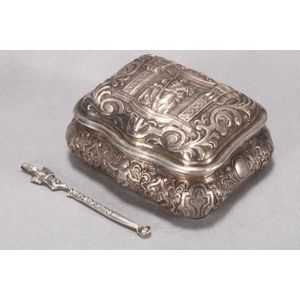Early 20th century Hanau silver snuff box, marks to base, with…
Early 20th century Hanau silver snuff box, marks to base, with Austrian import mark, of shaped casket form, the hinged cover embossed with Royal figure seated on throne, surrounded by embossed acanthus border, the sides embossed with putti, medallions and acanthus motifs, opening to a gilt interior, total weight 85gm, 3.5 cm x 6.5 cm x 5.5 cm, with matched silver snuff spoon (2). Provenance: collection of the late Fredric Sinfield, Sydney NSW, 1938 - 2008
You must be a subscriber, and be logged in to view price and dealer details.
Subscribe Now to view actual auction price for this item
When you subscribe, you have the option of setting the currency in which to display prices to $Au, $US, $NZ or Stg.
This item has been sold, and the description, image and price are for reference purposes only.
- Acanthus - A stylized leaf motif, one of the primary decorative elements of classical Greek and Roman architecture, derived from the genus of flowering plants in the family Acanthaceae, native to tropical and subtropical regions of the Mediterranean area. It is a common element in classical Greek and Roman design, and is often seen in Corinthian and Composite order columns and used as a decorative element in English, European and Australian furniture, particularly on the curve of a leg, and as decoration for a corbel.
- Embossed / Repousse - Embossing, also known as repousse, is the technique of decorating metal with raised designs, by pressing or beating out the design from the reverse side of the object.It is the opposite of chasing, where the decoration is applied from the front. An embossed or repoussed object may have chasing applied to finish off the design.
- Putto / Putti / Amorino / Amorini - A putto (plural: putti) or amerino (plural: amerini) is a cherub or cupid frequently appearing in both mythological and religious paintings and sculpture, especially of the Renaissance and Baroque periods and later used as a decorative element in the design of furniture, ceramics, statuary etc. They are usually depicted as chubby males, or of indeterminate gender, often with wings. Their depiction may represent an association with love, heaven, peace or prosperity.
This item has been included into following indexes:
- Hanau, Germany - precious objects 74
-
snuff boxes, country of origin
- Australian 40
- English, silver 399
